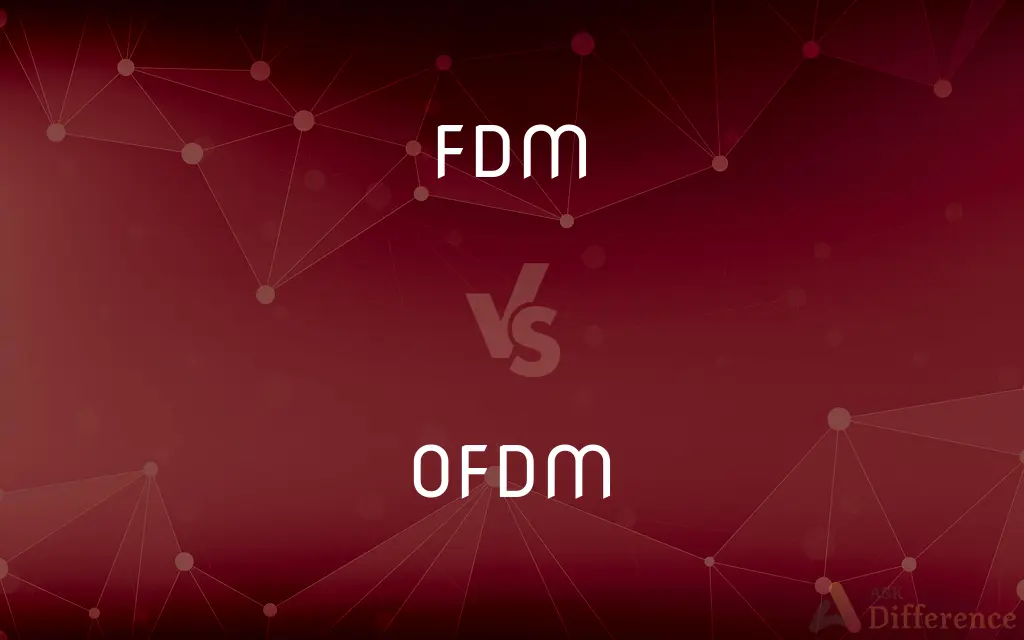FDM vs. OFDM — What's the Difference?
Edited by Tayyaba Rehman — By Fiza Rafique — Published on January 17, 2024
FDM (Frequency Division Multiplexing) assigns distinct frequency bands to different data streams, while OFDM (Orthogonal Frequency Division Multiplexing) uses overlapping, orthogonally spaced sub-carriers.

Difference Between FDM and OFDM
Table of Contents
ADVERTISEMENT
Key Differences
FDM, or Frequency Division Multiplexing, is a technique where the available bandwidth is divided into non-overlapping frequency bands, each carrying a separate signal. OFDM, or Orthogonal Frequency Division Multiplexing, also divides the bandwidth but uses closely spaced, overlapping sub-carriers that are orthogonal to each other to prevent interference.
In FDM, each channel uses a different frequency, and the separation between the channels prevents interference; however, this separation leads to inefficient use of the bandwidth. OFDM, on the other hand, maximizes spectral efficiency by allowing the sub-carriers to overlap, reducing the space between channels and making better use of the available bandwidth.
FDM is simpler to implement but less efficient in terms of bandwidth usage compared to OFDM. OFDM's complexity is higher due to its use of a Fast Fourier Transform (FFT) to decode the overlapping signals, but it allows for a more robust connection, especially in environments with multipath propagation.
While FDM is well-suited for analog and some types of digital communication, OFDM is the choice for modern high-speed digital communications, like DSL, LTE, and Wi-Fi, because of its ability to handle higher data rates and mitigate interference. OFDM's ability to cope with severe channel conditions, such as reflections and path fading, is far superior to that of FDM.
FDM was historically used in early telephone and radio relay systems, offering clear channel separation. OFDM, a more recent development, is essential in handling the fast and reliable data transfer required in today’s digital age, like streaming high-definition video or enabling broadband internet access over wireless networks.
ADVERTISEMENT
Comparison Chart
Channel Separation
Non-overlapping frequencies
Overlapping, orthogonal frequencies
Spectral Efficiency
Lower due to spacing between channels
Higher due to overlapping sub-carriers
Implementation Complexity
Simpler, with less processing needed
More complex, requires FFT for decoding
Suitability
Analog and early digital communications
High-speed digital communications (e.g., Wi-Fi, LTE)
Performance in Multipath
Susceptible to interference
More resilient, reduces multipath issues
Compare with Definitions
FDM
FDM separates the spectrum into distinct frequency channels for varied uses.
FDM is used in VHF and UHF bands to allocate different frequency slots to different users.
OFDM
OFDM is a frequency-division multiplexing scheme used in digital communications to combat signal fading and interference.
OFDM is a key technology in achieving the high-speed data rates of 4G networks.
FDM
FDM is a method of transmitting multiple signals simultaneously over separate frequencies.
The FM radio station uses FDM to broadcast several channels without interference.
OFDM
OFDM transmits large amounts of digital data over a series of orthogonal sub-frequencies.
Modern Wi-Fi routers use OFDM to efficiently manage data transmission within a network.
FDM
FDM allows simultaneous transmission of multiple signals at different frequencies.
The cable television service employs FDM to deliver multiple analog video and audio channels.
OFDM
OFDM utilizes the Fast Fourier Transform to decode overlapping but orthogonally spaced sub-carriers.
Broadband over power lines (BPL) uses OFDM to transmit data over electrical grids without interference.
FDM
FDM divides the available bandwidth into distinct frequency bands for different data streams.
Early telephone systems utilized FDM to route multiple calls through a single cable.
OFDM
OFDM works by encoding data on multiple sub-carrier frequencies that are mathematically orthogonal.
Digital television broadcasting has transitioned to OFDM for its ability to handle multipath interference better.
FDM
FDM allocates individual frequency bands to users or data streams in a shared medium.
Air traffic control communications use FDM to prevent signal overlap between aircraft.
OFDM
OFDM divides a frequency channel into multiple closely spaced sub-channels to maximize spectral efficiency.
LTE networks employ OFDM to accommodate more users in a given spectral band.
Common Curiosities
What does OFDM stand for?
Orthogonal Frequency Division Multiplexing.
How do FDM and OFDM use frequency bands differently?
FDM assigns separate, non-overlapping frequency bands to different signals, while OFDM uses overlapping, orthogonal sub-carriers.
Are FDM and OFDM compatible with each other?
They are different techniques and are not directly compatible, but both can be used in different parts of the same network.
What does FDM stand for?
Frequency Division Multiplexing.
Is FDM still in use today?
Yes, in some applications like radio broadcasting and satellite communication.
Which is more efficient in using bandwidth, FDM or OFDM?
OFDM is more efficient due to its overlapping sub-carriers.
How does OFDM improve performance in a multipath environment?
It reduces the interference and signal fading that can occur.
What type of communication systems commonly use FDM?
Analog broadcasting and early telephone networks.
Does FDM require more or less power than OFDM?
It typically requires less power due to its simpler implementation.
What is the main advantage of OFDM over FDM?
OFDM is more resistant to multipath interference and can carry higher data rates.
What type of communication systems commonly use OFDM?
Modern high-speed digital systems like Wi-Fi, LTE, and digital broadcasting.
Which is better for wireless communications, FDM or OFDM?
OFDM is generally considered better for wireless due to its resilience to interference and efficient bandwidth usage.
Is OFDM more complex to implement than FDM?
Yes, due to the need for FFT algorithms and digital signal processing.
Can FDM handle high-speed data like OFDM?
Not as effectively; OFDM is better suited for high-speed data transmissions.
Can OFDM be used for both upstream and downstream communications?
Yes, it's effective for bidirectional communication.
Share Your Discovery

Previous Comparison
McDouble Cheeseburger vs. Double Cheeseburger
Next Comparison
Slazenger Logo vs. Puma LogoAuthor Spotlight
Written by
Fiza RafiqueFiza Rafique is a skilled content writer at AskDifference.com, where she meticulously refines and enhances written pieces. Drawing from her vast editorial expertise, Fiza ensures clarity, accuracy, and precision in every article. Passionate about language, she continually seeks to elevate the quality of content for readers worldwide.
Edited by
Tayyaba RehmanTayyaba Rehman is a distinguished writer, currently serving as a primary contributor to askdifference.com. As a researcher in semantics and etymology, Tayyaba's passion for the complexity of languages and their distinctions has found a perfect home on the platform. Tayyaba delves into the intricacies of language, distinguishing between commonly confused words and phrases, thereby providing clarity for readers worldwide.
















































